Please support our coverage of democratic movements and become a supporting member of rabble.ca.
The Canadian Auto Workers (CAW) and Communications, Energy and Paperworkers (CEP) unions will be joined under the name Unifor. Their emblem will be a white ‘U’ over a red shield. So learned 150 local CAW and CEP representatives who had gathered at Toronto’s Sheraton Centre Hotel Thursday morning for the unveiling of their new, united union’s title and banner.
A union’s logo is a symbol that workers carry with pride, on their hard hats, on their membership cards, on their sleeves, explained Trish Hennessy of the Canadian Centre for Policy Alternatives, one of the speakers at the Thursday event.
The name, Unifor, denotes the unification of 300,000 members and 800 local unions under this new organization. The ‘U’ of the logo is comprised of two halves, each representing one of the national unions that came together to form the new one.
But Unifor’s name and logo are far more than a re-branding of old unions. They represent a radical new step in the labour movement, one that has been planned and refined since January, 2012. CEP and CAW leaders are adamant that Unifor is not a merger. It is the creation of an entirely new union, one with unprecedented scope and inclusivity.
“We’re going to open the doors to people who do not have traditional employment,” said CEP President Dave Coles.
That means inviting contract workers, students, retirees, the self-employed, the underemployed, even the unemployed, to become full voting members. “We’re going to offer membership to people in Canada who have never had the opportunity to be represented, or to have a voice, in labour before,” Coles said.
The open invitation to members, the first of its kind for a Canadian union, is an attempt to muster power in a harshly anti-labour climate. Canada’s labour groups have been fighting the hyper-capitalist politics of neoliberalism since the Brian Mulroney administration. More recent challenges, including the global financial crisis, and the election of a majority Conservative government, have resulted in attacks on workers’ rights from employers and politicians alike.
Until now, said CAW National Secretary-Treasurer Peter Kennedy, the CAW and CEP have been reluctant to modernize along with the changing labour landscape. Leaders from both unions agree, however, that Unifor will be a union for the future, attentive to the needs of Canadians in the 21st century.
In addition to embracing members who lack traditional forms of employment, Unifor will look to represent women, First Nations groups, visible minorities, and other demographics that have been left wanting for an equal voice in labour movements of the past.
The new union will also strive to make its materials more accessible, scrapping legalese for plain, easy-to-understand language.
Creating a union with the largest-ever scope of membership, renewing the power of the labour movement, and responding to the needs of hundreds of thousands of Canadians in every region of the country and every sector of the economy is no easy task.
CAW and CEP leaders recognize the early days will be a struggle. But as CAW President Ken Lewenza asked, “Would you rather raise expectations and fight for them, or would you rather continue in a culture of despair?”
He added, “We’re reaching for the top.”
Delegates from the CAW and CEP will meet at a Labour Day fouding convention to elect Unifor’s leadership.
Peter Goffin is a writer and recent political science graduate living in Toronto. His work has appeared in The Toronto Star, OpenFile, and This magazine.




